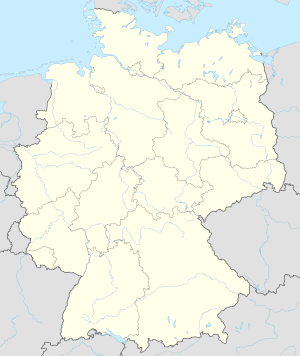Hobart Barracks
| Hobart Barracks AAF Station Detmold R-14 Fliegerhorst Detmold |
|
|---|---|
|
|
|
| Coordinates | 51°56′26″N 008°54′15″E / 51.94056°N 8.90417°E |
| Type | Military Airfield |
| Site history | |
| In use | 1934-1995 |
| Battles/wars | Western Front (World War II) |
Hobart Barracks is a former military airfield, located 1.6 km east-northeast of Detmold in North Rhine-Westphalia, Germany.
Flughaven Detmold was built in 1934 on the northeastern edge of the city and was intended for recreational (glider) flying. It was laid out as a 500x500 meters all-way grass airfield with a single hangar. Before it was opened it was already decided to expand the airfield to 700x700 meters. Later it was decided to expand the airfield even further (1000x1000m) to allow it to be used as an emergency airfield by the Luftwaffe. Civilians only got to use the airfield briefly though, as three months later the Luftwaffe took over the airfield on 15 February 1935 and they began converting it with a number of large hangars and a barracks compound west of the airfield. A flying school and school facilities were built.
Aircraft used in flight instruction were: Bücker Bü 131, Focke-Wulf Fw 44, Heinkel He 72 biplanes and Klemm Kl 35 monoplanes for primary training. Advanced trainers flown at the airfield were Arado Ar 66, Gotha Go 145, Heinkel He 46, Focke-Wulf Fw 58, Junkers W 33 and W 34s. Such a flying school typically had around 90 training aircraft, plus a few types for type instruction for front-line service. Types that frequented the airfield were Junkers Ju 52/3m transports, Messerschmitt Bf 109 and Bf 110 fighters and Heinkel He 111 bombers.
With the outbreak of the Second World War, front line units that used Detmold were III./JG 3 (Jagdgeschwader 3) (28 March - 10 April 1940) and 2./JG 27 (Jagdgeschwader 27) flying Bf 109Es (November 1940 - 10 January 1941). The airfield and its maintenance unit were involved in the production of the wooden Focke-Wulf Ta 154 twin-engine Moskito nightfighters. This occurred in part because the nearby furniture industry was used to produce parts for the aircraft, but development of the aircraft was terminated in late 1944. The airfield was never attacked by bombers, but allied fighters did attack it on several occasions.
...
Wikipedia

